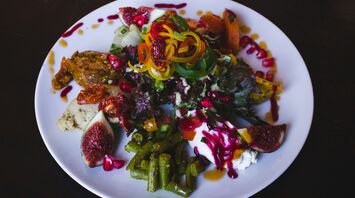What to Eat in Lebanon: From Flatbreads to Layered Desserts

Lebanese cuisine is a rich tapestry of fresh herbs, flaky pastries, and flavorful stews. Its fertile land, 140 miles of coastline, and position at the heart of the Middle East have created a diverse culinary tradition influenced by various cultures over millennia.
Influences on Lebanese Cuisine
Lebanon's cuisine has been shaped by numerous traders, conquerors, and colonizers. The Phoenicians introduced a love for seafood, the Romans established olive groves and vineyards, and the Ottomans brought barbecuing techniques. The French, who once colonized Lebanon, left behind a legacy of delicate pastries and haute-cuisine methods. Neighboring countries also play a significant role, with similar dishes appearing across the region, each with its own twist.
Essential Ingredients and Dishes
Lebanese home cooks expertly use beans, pulses, and grains, enhancing their flavors with aromatics and vegetables. Fasolia, a stew made with white beans, tomatoes, and garlic, becomes indulgent with a generous pour of olive oil. Mujadara, a hearty combination of lentils, rice, and caramelized onions, is another staple. Hummus is as beloved in Lebanon as it is throughout the Levant.
Garlic, olive oil, nuts, and spices like cumin and cinnamon are essential in Lebanese cooking, evoking the flavors of summer. Herbs are used generously, almost as vegetables, particularly in dishes like tabbouleh.
For dessert, most Lebanese families serve fresh fruit, but booza (stretchy ice cream) is a popular choice on hot days. Its unique texture comes from sahlab, made from orchid root. Baklava, a flaky, nutty pastry, is often enjoyed with a cup of cardamom-flavored Lebanese coffee.
Three Must-Try Lebanese Dishes
1. Manakish These flatbreads are a popular choice for breakfast or lunch. Named for their "engraved" appearance, they are often dimpled to hold flavorful toppings. Common options include aromatic za’atar with olive oil or cheese and vegetables.
2. Knafeh A beloved dessert throughout the Middle East, knafeh is made by layering shredded filo pastry with mild cheese or clotted cream. It's drenched in hot sugar syrup, resulting in a crisp exterior and gooey center.
3. Sambousek These fried pastries can be filled with a variety of vegetables, cheeses, and herbs. A popular version combines spinach, dill, coriander, parsley, and salty sheep’s cheese. Sambousek is often served as part of a mezze, accompanied by herbs, dips, and flatbreads.
Lebanese cuisine is a delightful exploration of flavors and textures, perfect for any food enthusiast. Whether you're enjoying a simple stew or a complex dessert, each dish offers a taste of Lebanon's rich culinary heritage.



















